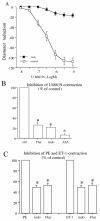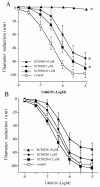Cyclooxygenase involvement in thromboxane-dependent contraction in rat mesenteric resistance arteries
- PMID: 15096470
- PMCID: PMC2233823
- DOI: 10.1161/01.HYP.0000127438.39744.07
Cyclooxygenase involvement in thromboxane-dependent contraction in rat mesenteric resistance arteries
Abstract
The influence of cyclooxygenase pathway activation following thromboxane-endoperoxide (TP) receptor stimulation was studied in rat mesenteric resistance arteries (n=6 to 10 per group). We studied isolated, perfused, and pressurized mesenteric resistance arteries (mean internal diameter 214 microm) using an arteriograph, enabling us to study arteries in physiological conditions of flow and pressure. Changes in diameter were continuously recorded, and contractions measured as internal diameter reduction. Release of cyclooxygenase pathway metabolites was also assessed by enzyme immunoassay (EIA) analysis of mesenteric bed perfusions. The thromboxane A2 (TxA2) analog U-46619 (1 micromol/L) induced a significant contraction (108 microm maximal diameter reduction). Inhibition by 3 chemically different cyclooxygenase inhibitors (ie, flurbiprofen, indomethacin, and aspirin) potently reduced the contraction to 27%, 25%, and 6% of control, respectively. The selective cyclooxygenase-1 inhibitor SC-58560 inhibited U-46619 contraction, whereas selective cyclooxygenase-2 inhibition (SC-58236) had no effect. Thromboxane synthase inhibition (furegrelate) did not affect U-46619-induced contraction, but it was reduced by cytosolic phospholipase A2 inhibition. Measurement of cyclooxygenase derivatives produced by the isolated mesenteric bed showed that PGE2 was produced after TxA2-receptor stimulation with U-46619. Exogenous prostaglandin E2 (in the presence of the TxA2 receptor antagonist SQ 29 548) and U-46619 contracted mesenteric arteries with a similar potency (EC50: 0.30 and 0.48 micromol/L, respectively). This study provides the first evidence that TxA2-receptor-dependent contraction in a resistant artery involved cyclooxygenase stimulation and, at least in part, a PGE2 formation. This mechanism of TxA2-dependent contraction in resistant arteries might be of importance in the understanding of diseases affecting resistant arteries and involving TxA2, such as hypertension.
Figures





References
-
- Narumiya S, Sugimoto Y, Ushikubi F. Prostanoid receptors: structures, properties, and functions. Physiol Rev. 1999;79:1193–1226. - PubMed
-
- Noll G, Luscher TF. The endothelium in acute coronary syndromes. Eur Heart J. 1998;19:C30–C38. - PubMed
-
- Cediel E, Vazquez-Cruz B, Navarro-Cid J, De Las Heras N, Sanz-Rosa D, Cachofeiro V, Lahera V. Role of endothelin-1 and thromboxane A2 in renal vasoconstriction induced by angiotensin II in diabetes and hypertension. Kidney Int Suppl. 2002;82:2–7. - PubMed
-
- Paarlberg KM, de Jong CL, van Geijn HP, van Kamp GJ, Heinen AG, Dekker GA. Vasoactive mediators in pregnancy-induced hypertensive disorders: a longitudinal study. Am J Obstet Gynecol. 1998;179:1559–1564. - PubMed
-
- Matrougui K, Maclouf J, Lévy BI, Henrion D. Impaired nitric oxide- and prostaglandin- mediated responses to flow in resistance arteries of Hypertensive rats. Hypertension. 1997;30:942–947. - PubMed
Publication types
MeSH terms
Substances
LinkOut - more resources
Full Text Sources
Other Literature Sources
Research Materials

